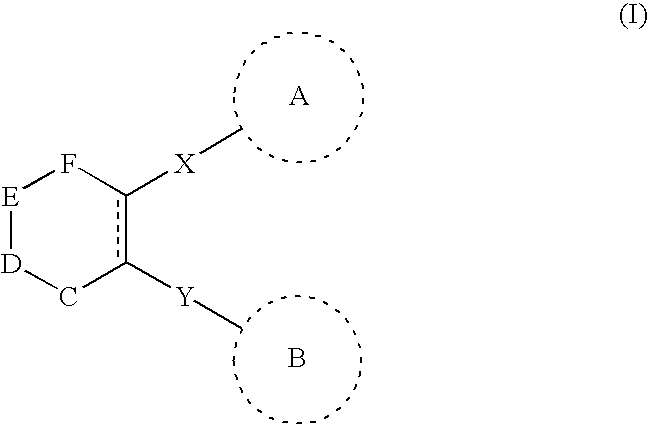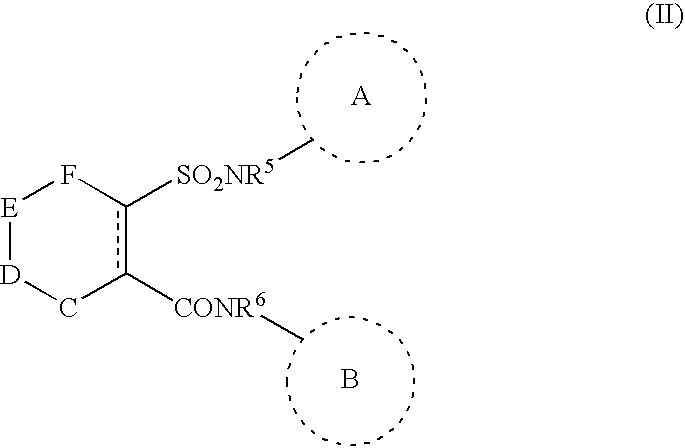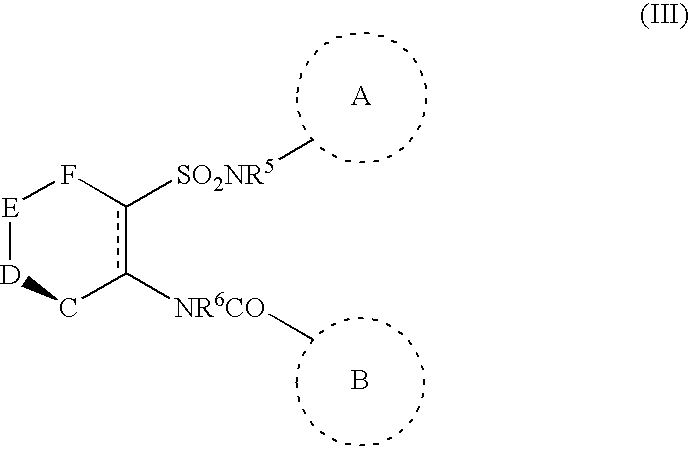Chemotherapeutic agents
a technology of chemotherapeutic agents and active ingredients, applied in the field of chemotherapeutic agents, can solve the problems of uncontrolled cell proliferation and death in mammals
- Summary
- Abstract
- Description
- Claims
- Application Information
AI Technical Summary
Problems solved by technology
Method used
Image
Examples
example 1
N-(2,6,-Diisopropylphenyl)-2-(2,6-diisopropylphenylsulfamoyl)-benzamide
2-Sulfobenzoic acid ammonium salt (1.8 g, 8.3 mmol) was dissolved in water (10 mL) and ion-exchanged using an IR-120 (acid form) ion-exchange column to give 2-sulfobenzoic acid as a white solid (1.6 g, 95%). 2-Sulfobenzoic acid (1.2 g, 5.9 mmol) was dissolved in thionyl chloride (20 mL) and DMF (0.2 mL) and heated at reflux for 15 h. On cooling the solvent was removed in vacuo to give 2-chlorosulfonylbenzoyl chloride as a clear yellow oil (1.4 g, 98%).
2,6-Diisopropylaniline (1.66 mL, 8.8 mmol) and triethylamine (1.23 mL, 8.8 mmol) were added dropwise to a solution of 2-chlorosulfonylbenzoyl chloride (1.0 g, 4.2 mmol) in chloroform (25 mL). The mixture was stirred under nitrogen at room temperature for 15 h. The solvent was removed in vacuo and the residue chromatographed on silica gel using ethyl acetate as eluent to give N-(2,6,-diisopropylphenyl)-2-(2,6-diisopropylphenylsulfamoyl)-benzamide as an off-white...
example 2
N-Phenyl-2-phenylsulfamoylbenzamide
2-Chlorosulfonylbenzoyl chloride (0.81 g, 3.4 mmol) and aniline (1.23 mL, 13.5 mmol) were dissolved in toluene (30 mL) and heated at reflux for 48 h. The solvent was removed under reduced pressure and the residue chromatographed on silica gel using ethyl acetate / petroleum spirit (40-60° C.) (1:3) as eluent to give N-phenyl-2-phenylsulfamoylbenzamide as an off-white solid (0.15 g, 13%). 1H NMR (200 MHz, CDCl3) δ 6.96-7.28 (m, 10H), 7.48-7.67 (m, 4H), 8.30 (br s, 1H), 8.95 (br s, 1H); MS ((APCI−)) m / z 351 (M−H); MS (APCI+) m / z 353 (M−H).
example 3
N-[2-(4-Methoxyphenylsulfamoyl)-phenyl]-isonicotinamide
4-Methoxyaniline (11.0 g, 8.12 mmol) was added to a stirred mixture of 2-nitrobenzenesulfonyl chloride (1.98 g, 8.93 mmol) and triethylamine (1.3 mL, 9.33 mmol) in dichloromethane (100 mL). The mixture was stirred at rt under nitrogen for 16 h. Reaction mixture was poured into water (100 mL), the organic layer separated, dried (MgSO4), and concentrated under reduced pressure to give N-(4-methoxyphenyl)-2-nitrobenzenesulfonamide as a tan solid (2.45 g, 98%).
A suspension of N-(4-methoxyphenyl)-2-nitrobenzenesulfonamide (0.21 g, 0.66 mmol) and 10% palladium on carbon (20 mg) in ethanol (20 mL) and acetic acid (0.2 mL) was vigorously stirred under a hydrogen atmosphere for 18 h at rt. The mixture was filtered through a celite plug and washed with ethanol. The solvent was removed under reduced pressure to give 2-amino-N-(4-methoxyphenyl)benzenesulfonamide as a white solid (0.18 g, 97%).
Dimethylformamide (0.1 mL) was added drop...
PUM
 Login to View More
Login to View More Abstract
Description
Claims
Application Information
 Login to View More
Login to View More - R&D
- Intellectual Property
- Life Sciences
- Materials
- Tech Scout
- Unparalleled Data Quality
- Higher Quality Content
- 60% Fewer Hallucinations
Browse by: Latest US Patents, China's latest patents, Technical Efficacy Thesaurus, Application Domain, Technology Topic, Popular Technical Reports.
© 2025 PatSnap. All rights reserved.Legal|Privacy policy|Modern Slavery Act Transparency Statement|Sitemap|About US| Contact US: help@patsnap.com



